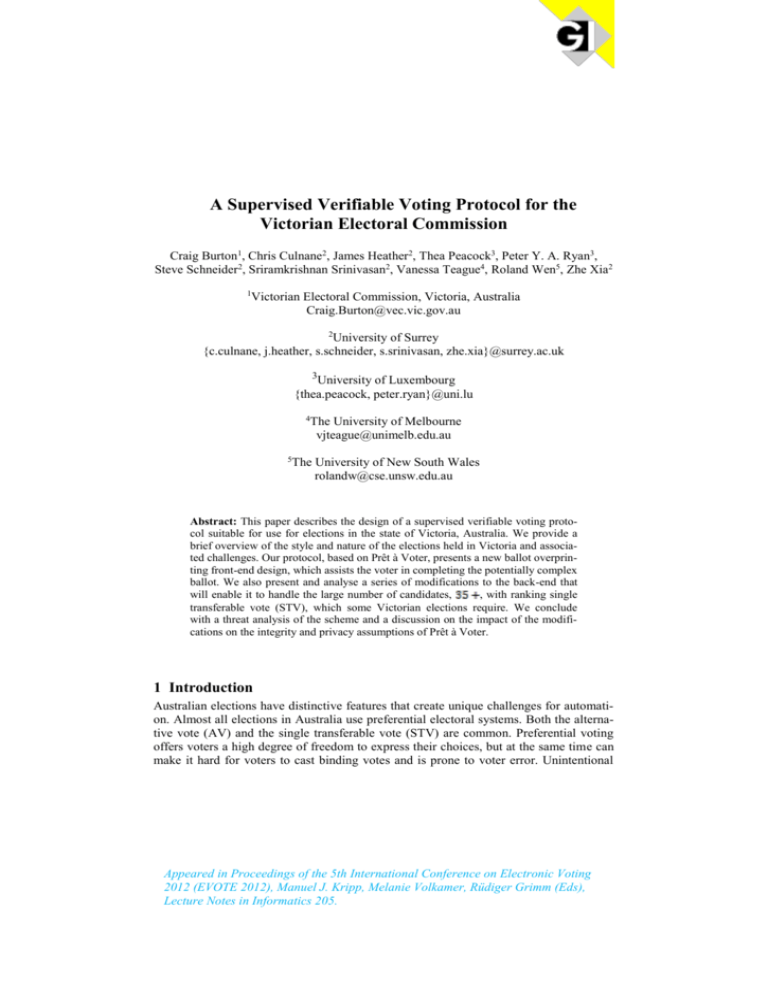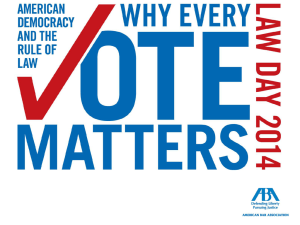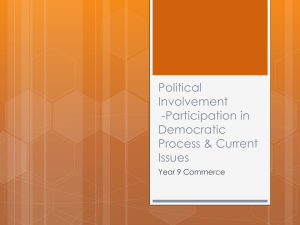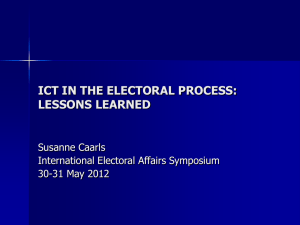A Supervised Verifiable Voting Protocol for the Victorian Electoral
advertisement

A Supervised Verifiable Voting Protocol for the
Victorian Electoral Commission
Craig Burton1, Chris Culnane2, James Heather2, Thea Peacock3, Peter Y. A. Ryan3,
Steve Schneider2, Sriramkrishnan Srinivasan2, Vanessa Teague4, Roland Wen5, Zhe Xia2
1
Victorian Electoral Commission, Victoria, Australia
Craig.Burton@vec.vic.gov.au
2
University of Surrey
{c.culnane, j.heather, s.schneider, s.srinivasan, zhe.xia}@surrey.ac.uk
3
University of Luxembourg
{thea.peacock, peter.ryan}@uni.lu
4
The University of Melbourne
vjteague@unimelb.edu.au
5
The University of New South Wales
rolandw@cse.unsw.edu.au
Abstract: This paper describes the design of a supervised verifiable voting protocol suitable for use for elections in the state of Victoria, Australia. We provide a
brief overview of the style and nature of the elections held in Victoria and associated challenges. Our protocol, based on Prêt à Voter, presents a new ballot overprinting front-end design, which assists the voter in completing the potentially complex
ballot. We also present and analyse a series of modifications to the back-end that
will enable it to handle the large number of candidates,
, with ranking single
transferable vote (STV), which some Victorian elections require. We conclude
with a threat analysis of the scheme and a discussion on the impact of the modifications on the integrity and privacy assumptions of Prêt à Voter.
1 Introduction
Australian elections have distinctive features that create unique challenges for automation. Almost all elections in Australia use preferential electoral systems. Both the alternative vote (AV) and the single transferable vote (STV) are common. Preferential voting
offers voters a high degree of freedom to express their choices, but at the same time can
make it hard for voters to cast binding votes and is prone to voter error. Unintentional
Appeared in Proceedings of the 5th International Conference on Electronic Voting
2012 (EVOTE 2012), Manuel J. Kripp, Melanie Volkamer, Rüdiger Grimm (Eds),
Lecture Notes in Informatics 205.
numbering errors are by far the largest category of errors contributing to informal 1 ballot
papers—comprising 50% of the total informal votes in the 2010 Victorian state election.
To help simplify the voting, STV elections often provide voters with the option of
selecting ‘group tickets’, which are predetermined preferences chosen by parties. This
can result in large and complex ballot papers. For example in Victorian elections, the
Legislative Council ballots have had up to 38 individual candidates and 11 group tickets.
Figure 1: Ballot paper for the Victorian Legislative Council
A sample ballot is shown in Figure 1. The ballot has a top section where voters can vote
for a party or group (known as voting ‘above-the-line’), and a bottom section where
voters can mark their preferences for individual candidate (known as voting ‘below-theline’).
There is a very tight turnaround for printing and delivering the ballots. Candidate
nominations typically close on a Friday with Early Voting commencing at 4pm the same
day. Ballots must be printed, checked and delivered as soon as possible, no later than the
following Monday morning.
Another important characteristic of Australian elections is compulsory voting. This
introduces numerous logistical challenges. For example, in state elections voters can cast
their votes at any polling place in their state, which means that ballot papers for every
electorate must be delivered to each polling place before the voting commences, and
then completed ballots must be returned to their correct electorates afterwards. Polling
places are also set up overseas, usually at Australian embassies.
There is a strong onus on electoral commissions to provide a high level of accessibility for all voters. The complexity of preferential ballots causes difficulties for marginalised voters, in particular for voters with a print disability and voters from non-English
speaking backgrounds. Many voters in these categories require human assistance to fill
out their ballots, in which case they have no protection of vote secrecy. E-voting has the
1
by informal we mean any vote that is incorrectly filled and/or somehow ambiguous and non-binding
potential to help solve many of these problems. Although electoral commissions in Australia have generally been cautious about e-voting, there have been strong pushes towards
adopting e-voting over the last five years.
The Victorian Electoral Commission (VEC) is one of the early adopters of e-voting
in Australia. In 2006, the VEC trialled a supervised e-voting system provided by a thirdparty vendor, and the system was rolled out on a larger scale in 2010. The e-voting system offered several benefits for both voters and the VEC. The voting machines alerted
voters to numbering errors and provided instructions in a choice of 12 languages. All
machines were equipped with audio facilities to provide guidance and feedback to vision
impaired voters. The electronic nature of the ballots helped reduce the administrative
overhead and physical security risks of returning the ballots through multiple third parties (for instance couriers); the ballots were submitted to centralised servers via a private
network.
However there were a number of concerns with this system. First and foremost, the
system did not provide any meaningful verifiability of the votes. In addition, the
proprietary nature of the system meant that none of the design and implementation details could be made public. The necessary heavy customisation of the vendor’s core
product (for instance to handle preferential ballots) created difficulties in tightly integrating the e-voting system with the VEC’s existing election administration process (such as
allowing general staff to run the entire system), and in deriving ongoing benefit from the
supplier’s core solution, which is on another development branch.
To address these shortcomings, the VEC has decided to develop its own e-voting
system in collaboration with the e-voting community. Academics from several universities are working with the VEC to design a suitable cryptographic e-voting protocol that
provides both individual and universal verifiability. The design and the final system will
be publicly available for peer review. The VEC’s vision is for voters to cast their votes
using the machines, which will provide (optional) take-home receipts for voters to verify
their votes.
One of the main challenges is in finding the right balance between usability and
security, in particular requiring voters to verify large amounts of information in preferential ballots and to perform cryptographic operations such as verifying digital signatures.
Our main contribution is not in the proposal of the protocol, but more importantly in
highlighting the difficulties and potential trade-offs in practice when applying cryptographic voting schemes to large-scale public elections that have specific requirements.
1.1 Related works
The present work is based on the Prêt à Voter (PaV) electronic voting system [Rya04,
CRS05]. The original PaV scheme has subsequently undergone various adaptations and
enhancements, some of which are described elsewhere in this paper. The basic concept
remains unchanged and is described as follows.
The voter receives a printed ballot as shown in Fig. 2 below. The order of the candidates is independently randomised for each ballot and the value “7rJ94K” represents an
encryption of the order on the form.
Beta
Gamma
Alpha
7rJ94K
Figure 2: A Prêt à Voter ballot form
In the polling station, the voter is given at random a ballot sealed in an envelope. She
takes this to the booth, extracts the ballot form, marks the candidate of choice, separates
the right-hand and left-hand sides (RHS, LHS) and destroys the LHS. She can now leave
the privacy of the booth with the RHS of the ballot form. In the presence of officials and
perhaps observers, the RHS is placed under an optical reader which records the information, that is, the value at the bottom of the strip and the position marked or the preferential rankings. The RHS, or a copy thereof, is retained as a receipt. Note that as the candidate order is randomised and has been destroyed, the receipt does not reveal her vote
(except to someone possessing the decryption keys). The decryption keys are shared
between a set of parties such that a threshold set of these parties is required to perform
decryption. This ensures that no single party can decrypt all ballots. Once all voting has
ceased, the receipts are posted on a secure Web Bulletin Board (WBB). Voters can use
this facility to confirm that their receipts appear correctly. A set of mix servers then
perform a series of robust, anonymising, re-encryption mixes (e.g. [Nef01, FS01,
Wik10]) on the receipts and the votes are emitted and counted.
Although apparently simple on the surface, the underlying protocol offers many of
the properties desirable in voting systems such as, ballot secrecy, individual and universal verifiability and receipt-freeness. As PaV has a certain similarity to traditional penand-paper, booth-based voting, the user experience is familiar and hence, the scheme is
readily adaptable to real-world situations.
The original scheme was designed for First-Past-The-Post (FPTP) voting as currently
used in the UK, but it is clear that it adapts easily to ranked, AV etc.: the voter simply
adds further marks to the ballot. However, if done naively, this opens up possibilities of
“Italian” style attacks. This has been addressed in [TRN08, XCH10], which introduce
new mixing and tallying algorithms.
Certain fielded, verifiable voting systems offer potential for ranked voting such as,
Scantegrity II [CCC08] and Civitas [CCM08]. However, it is unclear how they would
perform with a large number of candidates. The “checkerboard style” ballots in Scantegrity II would for instance, be impractical with potentially
candidates. Encoding of
vote preferences in Civitas could incur a significant processing overhead when scaled up
for a sizeable candidate base. Furthermore, Civitas is a remote rather than supervised
scheme. Wombat (http://www.wombat-voting.com/) is currently implemented as a FPTP
supervised system, but again it is unclear how it would handle a large number of ranked
vote choices. There could also be privacy issues connected to the plaintext audit trail
provided by Wombat ballots.
With the PaV implementation for the VEC, we note that although workable solutions
have been found for the moment, many research challenges remain. Whilst a formal
security analysis has yet to be carried out, security of the scheme is forefront in the deve-
lopment process and is being continuously monitored and discussed by all parties involved.
2 Front-End Design
We now describe the proposed system.
2.1 Electronic Ballot Marking
In this section, we introduce the procedures of vote casting. In other words, how to capture the voter’s intent into an encrypted vote and how to verify that the encrypted vote
has been correctly recorded by the election system.
Echo
Bravo
Alpha
Delta
Charlie
{P}
An example ballot is shown as in the above table. It contains a perforation vertically
down the middle so that the two halves can be separated. The LHS lists the candidates in
a random order. In the bottom of the LHS, there is also an unencrypted representation P
of the candidate order (e.g. it can be a computer-readable barcode). The RHS is left
blank for the voter to mark her rankings. Moreover, in the RHS, an encrypted value,
called an onion is associated with each candidate. If it is decrypted, its plaintext will
represent the corresponding candidate in the LHS. The encoding of the onions is explained in section 3.
In contrast to the traditional PaV protocol, the voter does not mark her preferential
rankings on the ballot directly. This is because the state of Victoria’s upper house election contains around 36 candidates, and ranking so many candidates using a candidate
list in the random order is obviously not user friendly. Instead, we will use a voting device, called an Electronic Ballot Marker (EBM), to help the voter mark her rankings.
The EBM is a standalone, isolated computer device with a barcode reader and touch
screen user surface. To cast a vote, the voter first inserts the ballot into the EBM, which
will read the permutation information P in the bottom of the LHS. The EBM displays the
ballot on its touch screen user surface such that the candidate list is in the official draw
order. The user interacts with the touch screen to give her preferential rankings. Note
that the EBM can also assist the voter by pointing out ill-formed vote. Once the vote is
confirmed, the EBM sorts the voter’s rankings according to the permutation information
P, and overprints the results on the RHS of the ballot.
The voter takes her completed ballot paper to a scanner. As with the conventional
PaV, she separates the ballot along the perforation, destroys the LHS and then places the
RHS into the scanner. After that, the scanner submits the preferences and onions to the
WBB, which will then generate a hash value of the received information and send the
digital signature of the hash value back to the scanner. The scanner now overprints the
signed hash onto the RHS, which can then be taken away by the voter as her receipt.
The voter can optionally audit either the entire or part of the vote casting procedures.
Here, we explain how the complete auditing should be carried out:
• Audit the ballot: This audit checks whether the ballot is correctly generated. In
other words, whether each onion in the RHS correctly encrypts the corresponding
candidate in the LHS, and whether the permutation information P contains the
correct candidate order. A ballot can be either audit or cast, but not both. The auditing method is as in the traditional PaV [CRS05].
• Audit the EBM: The EBM transfers the voter’s rankings wrt the candidate list in
the canonical order, to rankings wrt the candidate list printed in the ballot. This
audit checks that the transformation is done properly. For example, the voter can
randomly note down some or all of the candidate-preference pairs from the
EBM’s touch screen surface and then compare whether these pairs are consistent
with those printed on the ballot.
• Audit the vote recording: This audit ensures that the encrypted vote has been correctly recorded by the WBB. To perform the audit, the voter calculates a hash value of the preferences and onions in her receipt and then checks whether the signed hash from the WBB is valid.
2.2 Digital Signature Issues
One of the fundamental principles of PaV is the issuing of a receipt that the voter can use
to verify that their vote has been correctly recorded onto the WBB. It is this checking
that assures the voter that their vote is being included in the count. If anything is amiss,
the information on the receipt is different or missing from the WBB, the voter can challenge the authorities. As such, the veracity of the receipt is vitally important.
A valid receipt provides protection for two parties: it provides the voter with evidence to launch an appeal, whilst simultaneously providing the system with protection
from false accusation. It is therefore essential that any issued receipt is verified by the
voter when received. If it is invalid or false, the voter must appeal at that point. Once the
voter has left the polling station their right to appeal about false receipts is over.
The difficulty is that it is easy to verify a digital signature on a computer, but impossible for a human to do it in their head. When in the polling station the voter is virtually
devoid of any trusted hardware and therefore does not have the ability to check the veracity of the digital signature in a way that is assured and trusted by them.
Alternative approaches have been suggested ([CBH11, Rya11]), that either augment
or entirely do away with the digitally signed receipt. Such schemes are based on verifying codes to ensure that the vote has been accurately recorded on the WBB. Such
schemes have the desirable property that when the voter leaves the polling station they
have already completed their verification step. However, they do require a higher level
of trust in the WBB, although there already exists a degree of trust in it with the digital
signatures. The bigger disadvantage is that the codes used to verify the recording of the
vote must be distributed to the voter. The typical suggestion is to include them on the
ballot form issued to the voter. However, this then places a chain of custody requirement
on those ballots, which if breached could potentially undermine integrity. There may be
situations where such a chain of custody already exists or where it is a preferred compromise to the digital signature approach.
The final and preferred option is to permit voters to use their mobile phones to verify
the digital signature. Constructing a phone application to do such a task is relatively easy
and multiple organisations could undertake such a task and provide it for free, allowing
voters to use an app from an organisation they trust or perhaps even build their own.
Such an approach does require that the voter is in possession of a smartphone and that
they sufficiently trust the device and the application to perform the operation. There is
growing concern about malware on mobile devices, but currently the average user is
likely to trust such a device. There are concerns about disenfranchising the less well off
or older generation who tend not to own smartphone devices. Whilst this is true, the
validity of the system only requires a small number of people to check their receipt.
Unless the machine/system can know in advance whether someone has a smartphone, it
cannot risk cheating in case it gets caught. There may also be legislative problems with
allowing phones and photographic devices to be used in a polling station, however, provided that the process is well managed and checking is performed in a designated area,
such concerns should be mitigated. It is worth noting that the checking of the signature
can be performed within the polling station, in public with assistance if required.
3 Back-End Design
In this section, we discuss how to tally the received encrypted votes into the election
result.
We will use the Exponential ElGamal cipher [ElG85] in our protocol. A plaintext
message will be encrypted as
. In the ballot form, there will be a
ciphertext next to each candidate. Suppose there are candidates in the election, the -th
candidate will be encoded as
, where
is a value larger than
(e.g.
). A received vote will look similar to the following table (note that the columns might be in different orders, but the tally methods will not be affected):
Ciphertext
Ranking
R1
R2
…
…
Rk
3.1 Tally Method 1
We first sort the ciphertexts within the above table according to their rankings. The result will be a -ciphertexts tuple
ranked in the canonical order. We then
treat each of the ciphertext tuples as an input to the mixnets (e.g. Verificatum [Wik10]).
After the shuffle, all ciphertexts in the outputs are decrypted, and the election result will
be calculated. However, the drawback of this method is that the computational cost for
the shuffle and decryption phase will be expensive if the number of candidates is large.
Hence it is not ideal for elections with large numbers of candidates.
3.2 Tally Method 2
Alternatively, for a particular vote, we can use the homomorphic properties of the exponential ElGamal cipher to first aborb all the ciphertexts and their corresponding rankings
into a single ciphertext as follows2:
where
. Then for each vote, we input the ciphertext
into the
mixnets. After the shuffle, all the ciphertexts will be decrypted. Hence, somewhere in the
outputs, there will be a value
. In order to retrieve
from
, we can build up a
look-up table for all (
) value pairs in advance (e.g. even before the tally phase
starts). After the decryption, we search the table to retrieve the value , and the ranking
choice for this vote can be calculated using the value .
This method is superior to Tally Method 1 because the computational cost for the
shuffle and decryption phase has been reduced to the minimum: for each vote, there is
only one ciphertext to be shuffled and decrypted. However, the disadvantage is that we
need to build a look-up table in order to retrieve the plaintext. For an election with
candidates, the look-up table will contain
different (
) values. So for elections
with small numbers of candidates (e.g. Victoria’s lower house election with around 7
candidates), to build such a look-up table is perfectly reasonable. But for elections with
large numbers of candidates, it will be infeasible to build such a look-up table. For example, Victoria’s upper house election will have
candidates, and the size of the
look-up table for 36 candidates is
.
3.3 Tally Method 3
The third tally method can be considered as a trade-off between the above two methods.
It is specially designed for elections with large numbers of candidates. We use Victoria’s
upper house election as an example to demonstrate the idea (we assume there are 36
candidates).
Similar to the Tally Method 1, for a received vote as shown in the above table, we
first sort all its ciphertexts into a k-ciphertexts tuple
which is ranked in the
canonical order. Now, start from the first ciphertext in the tuple, we treat every
ciphertexts as a group. Hence for the VEC election, if we set the size of the group
,
we can separate all 36 ciphertexts into
groups. As follows, we treat each group
as ciphertexts ranked from 1 to .
The following processes will be similar as in the Tally Method 2. For each of the sizes group
where
, we will absorb all its
ciphertexts into a single ciphertext using the homomorphic property as follows:
Hence, we have packed a -ciphertexts tuple into
2
tuples of -ciphertexts each as
Note that in order to ensure the correctness of the election result, we need to ensure that is always smaller
than which is the order of . For 128-bit, 256-bit and 512-bit , we can handle at maximum 27, 47 and 81
candidates respectively.
At this moment, for each received vote, we input its
many -ciphertexts tuples
into the mixnets. After the shuffle, all ciphertexts in the outputs are decrypted. Note that
after the decryption, somewhere in the outputs, we only obtain
and we still need one look-up table to retrieve their plaintexts {
}. This
time, the size of the look-up table is
which is much smaller than
. In our
case, for
and
, the size of the table is
.
We have shown a special case above that
. In case if
where
, the above method still works. Now, we can group the ciphertexts into several
-sizes groups and the remaining ciphertexts are treated as a group. In such a case, we
build two look-up tables, one with size
to look up the -sizes ciphertext
groups and the other with size
to look up the -sizes ciphertext group.
Therefore, thanks to this tally method, we are able to handle elections with large
numbers of candidates. We can carefully choose the value (how many ciphertexts to be
absorbed into a single ciphertext) so that the size of the look-up table
is reasonable.
Meanwhile, the shuffle and decryption phase is -times faster than the Tally Method 1.
4 Discussion
In the previous sections, we tried to clarify the fundamental design ideas in a simple
way, so some technical details and design decisions are left out. In this section, we discuss some of these issues.
Where are the onions stored? : In section 2, we mention that in the RHS, an encrypted value, called an onion is associated with each candidate. This implies that
the onions are printed on the RHS. However, in order to achieve the proper
security level, the size of each onion will be around 1KB. Obviously, it will be
impractical to print 36KB data on the paper ballot. To solve this problem, we
suggest the onions are recorded on the WBB, and that they are linked to a particular ballot using some unique serial number.
Italian attack: There are two types of Italian attack. The first type works for
elections in which the voter can express her preference in a large number of
ways. Coercers can force a voter to cast her vote in a unique way that no one else might use. Hence, if coercers find out that no one has cast a vote in this way,
the voter will be caught. The second type works for elections in which the transfer history is revealed. Coercers can force a voter to rank an unpopular candidate
before a popular candidate. Hence if that unpopular candidate is eliminated but
there is no vote transfer to the popular candidate, the voter will be caught. The
tally methods in this scheme prevent neither type of Italian attack. But this is a
design decision to tradeoff security for the sake of efficiency. In the literature,
although some schemes (e.g. [TRN08, BMN09, XCH10]) are able to solve the
Italian attacks, their computational cost will prevent them from being implemented in practice at the moment.
Ballot validity proof: Generally speaking, in verifiable elections with homomorphic tallying, every ballot should contain some validity proof which proves that
each ciphertext encodes one of the pre-defined values. Otherwise, a faulty ballot
could ruin the election result by introducing thousands of extra votes. In our design, although the homomorphic property has been used in the tally phase, it is
only used within the ballot itself to encode the preferences but not across different ballots. Hence the ballot validity proof is not required. Any invalid ballot
can only ruin itself: it could neither introduce extra votes nor ruin the other
ballots.
Impact of the different tallying methods: In section 3, although we have introduced three different tallying methods, the first two are just special cases of the
last method. The major difference lies in how many ciphertexts can be absorbed
into a single packing. Election authorities should choose this parameter based on
different circumstances, and the selection will only affect the computational cost
in the tallying phase rather than the security properties.
Vote packing using small primes: There is an alternative method to pack the
ranking information using small primes [PABL04]. For example,
are small primes representing each of the candidates, and
are their
rankings respectively. Then the vote can be packed as
.
However, compared with the method we have introduced in the paper, this method has two drawbacks. Firstly, when using small primes as counters, the aggregated value will grow very quickly as the number of candidates increases. If
such value is larger than , it will be wrapped around by , and we still need a
look up table when retrieving the ranking choices. Moreover, this might cause
collision problem as well. Secondly, safe primes (primes of the form
) need to be used, so that small primes in
can be selected as the
counters. However, this results in a much larger size of , which will make
many calculations much slower. With our method, primes of the form
where
can be used to speed up ballot generation and tallying
without affecting security.
5 Security Properties
In this section we will briefly discuss how the modifications made to standard PaV impact on the security properties normally associated with PaV. There are a number of
security properties that are important to an electronic voting scheme. They are:
• Integrity
• Verifiability
• Privacy
• Robustness
• Receipt-freeness
• Usability
• Coercion Resistance
The integrity and receipt-freeness properties of the proposed system are identical to that
of standard PaV. The manner in which the ballot form is filled out has changed, but not
the underlying casting process or receipt construction. Likewise the verifiability properties are transferable, provided that the voter performs the necessary checks; namely checking the overprinting and the digital signature. It could be argued that this is a harder
task with the proposed system, given the quantity of information that needs checking.
However, the system does make it is easier to correctly complete the complex ballot
form. The complexity of checking is a consequence of the complexity of the election, not
the underlying system. Whilst the area of usability has improved in one sense, the filling
out of the ballot, it may have suffered in how the overprinting approach will work. This
requires further analysis and trials to determine how easy and reliable it is for the voter
to perform.
The issue of robustness is constantly considered and has influenced the design, with
aspects like the WBB peered among different parties. The robustness of the system is
dependent on both the technology and the procedures surrounding it and is still being
refined. The issue of requiring a network connection throughout the election in order to
submit votes to the WBB and receive digital signatures back is a possible weakness.
Various fallback options are still being discussed and analysed to determine the best
compromise.
It is the privacy property that is most effected by the proposed changes. The system
now utilises an EBM that learns the vote. Strategies for mitigating this have been included, for example enforcing that the EBM is offline and is wiped at the end of the
election. However, there is a new trust assumption here, that the EBM has been honestly
setup and has not been compromised in some way to record and transmit the votes.
The issue of coercion resistance is impacted by the changes in privacy. Coercion resistance is far more complicated, since it also covers the perception of the voter. A weakening in the privacy guarantees would likely reduce coercion resistance; such a discussion is beyond the scope of this paper.
6 Conclusion
In this paper we have presented an end-to-end verifiable voting scheme, which would be
suitable for use in a Victorian state election. We have detailed the modifications we
would need to make to standard PaV in order to comply with the requirements of scale,
usability and legislation. In trying to move from theory to practice, modifications and
compromises are a necessity. The challenge is choosing the right compromises and being
able to adequately justify them. Whilst some of these modifications are specific to the
state of Victoria, for example above-the-line and below-the-line voting, the process we
have undertaken is transferable to alternative scenarios.
Acknowledgement
This work has been partially funded by the UK Engineering and Physical Sciences Research Council (EPSRC) under project 'TVS: Trustworthy Voting Systems'
(EP/G025797/1) and the Luxembourg National Research Fund (FNR) under project
SeRTVS-C09/IS/06.
Bibliography
[BMN09] Josh Benaloh, Tal Moran, Lee Naish, Kim Ramchen, and Vanessa Teague. ShuffleSum: coercion-resistant verifiable tallying for STV voting. IEEE Transactions on Information Forensics and Security, 4(4), 2009.
[CBH11] Chris Culnane, David Bismark, James Heather, Steve Schneider, and Sriramkrishnan
Srinivasan. Authentication codes. Proceedings of the 6th USENIX/ACCURATE Electronic
Voting Technology Workshop (EVT’11), 2011. San Francisco, CA.
[CCC08] David Chaum, Richard Carback, Jeremy Clark, Aleksander Essex, Stefan Popoveniuc,
Ronald L. Rivest, Peter Y. A. Ryan, Emily Shen, and Alan T. Sherman. Scantegrity II: endto-end verifiability for optical scan election systems using invisible ink confirmation codes.
Proceedings of the 3rd USENIX/ACCURATE Electronic Voting Technology Workshop
(EVT’08), 2008. San Jose, CA.
[CCM08] Michael R. Clarkson, Stephen Chong, and Andrew C. Myers. Civitas: toward a secure
voting system. 2008 IEEE Symposium on Security and Privacy, 2008.
[CRS05] David Chaum, Peter Y. A. Ryan, and Steve A. Schneider. A practical voter-verifiable
election scheme. Proceedings of the 10th European Symposium on Research in Computer
Science (ESORICS’05), pages 118–139, 2005. LNCS 3679.
[ElG85] Taher ElGamal. A public key cryptosystem and a signature scheme based on discrete
logarithms. IEEE Transactions on IT, 31(4):467–472, 1985.
[FS01] Jun Furukawa and Kazue Sako. An efficient scheme for proving a shuffle. Advances in
CRYPTO’01, pages 368–387, 2001. LNCS 2139.
[Nef01] C. Andrew Neff. A verifiable secret shuffle and its application to e-voting. Proceedings
of the 8th ACM Conference on Computer and Communications Security (CSS’01), pages
116–125, 2001.
[PABL04] Kun Peng, Riza Aditya, Colin Boyd, and Byoungcheon Lee. Multiplicative homomorphic e-voting. In Advances in Cryptology - Indocrypt 04, pages 61–72, 2004. LNCS 3348.
[Rya04] Peter Y. A. Ryan. A Variant of the Chaum voter-verifiable scheme. Technical Report of
University of Newcastle, CS-TR:864, 2004.
[Rya11] Peter Y. A. Ryan. Prêt à Voter with confirmation codes. Proceedings of the 6th USENIX/ACCURATE Electronic Voting Technology Workshop (EVT’11), 2011. San Francisco,
CA.
[TRN08] Vanessa Teague, Kim Ramchen, and Lee Naish. Coercion-resistant tallying for STV
voting. Proceedings of the 3rd USENIX/ACCURATE Electronic Voting Technology Workshop (EVT’08), 2008. San Jose, CA.
[Wik10] Douglas Wikström. Verificatum, 2010. http://www.verificatum.org/verificatum/.
[XCH10] Zhe Xia, Chris Culnane, James Heather, Hugo Jonker, Peter Y. A. Ryan, Steve Schneider, and Sriramkrishnan Srinivasan. Versatile Prêt à Voter: Handling multiple election methods with a unified interface. In Indocrypt: 11th International Conference on Cryptology in
India, 2010. LNCS.







